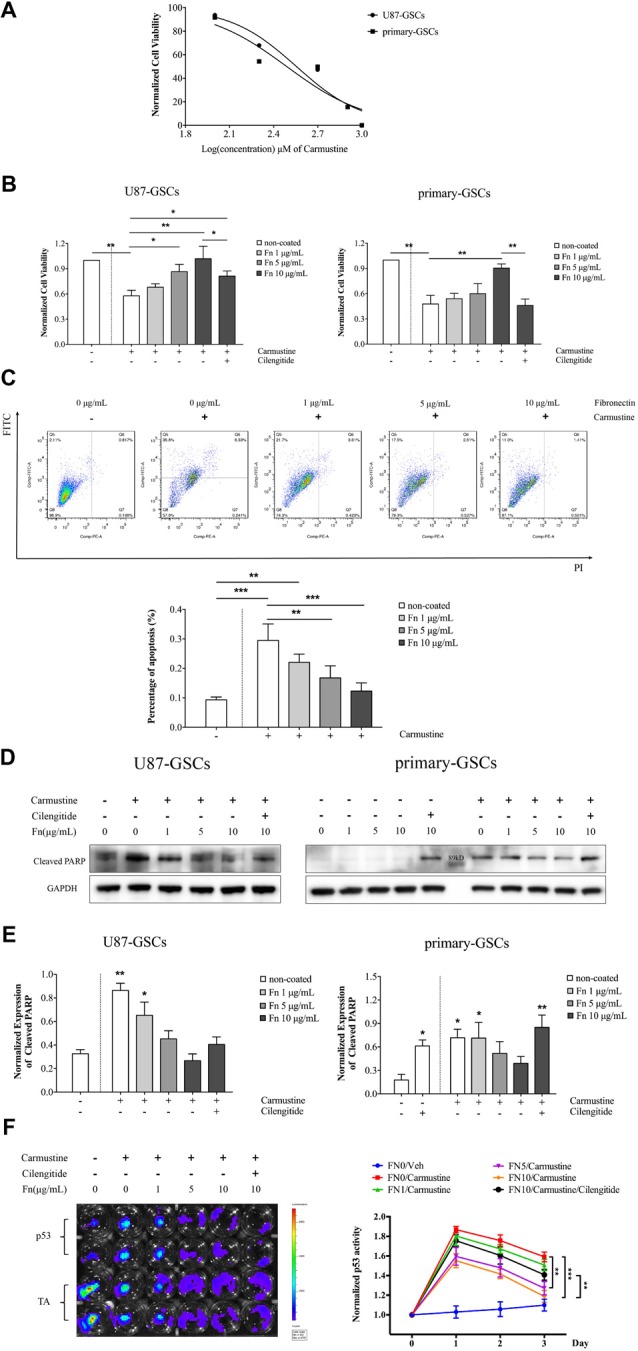Figure 4.

FN inhibited p53-mediated apoptosis induced by carmustine. (A) A dose inhibition curve of carmustine treated GSCs revealed a half maximal inhibitory concentration (IC50) of 504.3 ± 25.3 μM for U87-GSCs and an IC50 of 395 ± 19.4 μM for primary-GSCs. (B) Cell viability indicated that compared to the control group, U87-GSCs and primary-GSCs in the absence of FN were markedly inhibited by carmustine (p < 0.01 for both). Nevertheless, growing U87-GSCs on 5 or 10 μg/mL FN totally restored cell viability (p < 0.05 and p < 0.01, respectively). Only primary-GSCs grown on 10 μg/mL FN showed restored cell viability (p < 0.01). Compared to the cells grown on 10 μg/mL FN, cilengitide decreased cell viability significantly for both U87-GSCs and primary-GSCs (p < 0.05 and p < 0.01, respectively). (C) Apoptosis, as determined by flow cytometry, revealed that U87-GSCs grown on 5 or 10 μg/mL FN showed significantly decreased apoptosis induced by carmustine (p < 0.01, p < 0.001, respectively). (D,E) Western blots also revealed cleaved poly (ADP-ribose) polymerase (PARP) expression increased significantly in U87-GSCs grown in the absence of or on 1 μg/mL FN, but decreased in GSCs grown on 5 or 10 μg/mL FN (p < 0.01 and p < 0.05, respectively). In contrast, cilengitide reversed the anti-apoptotic effect of FN to a slight degree at a concentration of 100 μM. For primary-GSCs, cilengitide alone induced higher expression of cleaved PARP (p < 0.05 and p < 0.01 for 0 and 10 μg/mL FN, respectively). In accordance with U87-GSCs, higher levels of cleaved PARP expression were present in primary-GSCs when not grown on FN or grown on 1 μg/mL FN and treated with carmustine (p < 0.05 for both). In contrast to U87-GSCs, when primary-GSCs were treated with carmustine and cilengitide, they showed a markedly higher expression of cleaved PARP (p < 0.01). (F) Luciferase luminescence assays were used to determine p53 activity. The activity of p53 was elevated slightly without carmustine treatment in U87-GSCs grown in the absence of FN. However, p53 activity was increased markedly by carmustine, with a peak on day 1, but declined in the following 2 days. Compared to U87-GSCs grown in the absence of FN and treated with carmustine, the p53 activity of U87-GCSs was suppressed dramatically when grown on 5 or 10 μg/mL FN. The restoration of p53 activity was observed when U87-GSCs were grown on 10 μg/mL FN and treated with cilengitide. *p < 0.05, **p < 0.01, ***p < 0.001.
